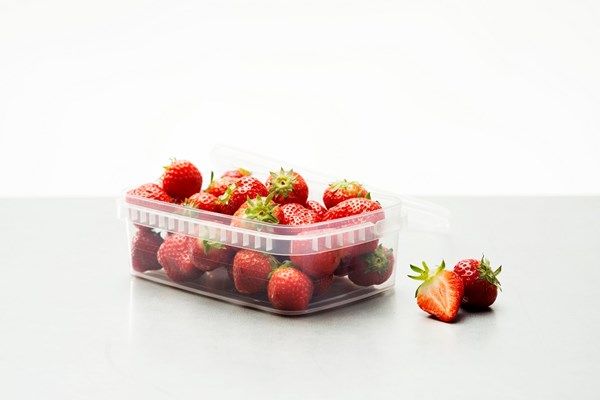Thin-Walled Biobased Packaging That’s Injection-Moldable and Commercially Viable
A consortium in The Netherlands has come up with an innovative three-pronged approach.

Biobased plastics are rarely used in injection-molded food packaging (e.g., salad, butter, tomato containers), but an interesting new consortium formed in The Netherlands is aiming to change this. Despite food producers interest in biobased packaging, the biggest hurdle is that this interest dramatically drops when they calculate what the switch to these materials would cost, according to senior polymer scientist Gerald Schennink of Wageningen Food & Biobased Research.
Similarly, Niels L’Abee, director of SFA Packaging, an innovative processor with one of the largest range of injection-molded food packaging offerings (from 90 millimeters/3.5 in. to 42 litres/11.1 gal) in Europe, notes:
“From clients we see no explicit willingness to pay extra, but at the same time everyone feels that there should be more environmentally-friendly packaging available… a trend that is even more evident among consumers.”
This led L’Abee and Wageningen Food & Biobased Research to take the initiative to study whether commercially-available biobased plastics could be made more suitable for this type of applications. The two entities are now part of a recently established public-private consortium aiming to achieve this goal. It is funded by the Dutch government’s Agri&Food Top Sector, and also includes injection molding machine maker Arburg packaging molder TN Plastics BV.
Noting that there are several biobased plastics on the market, most of which are suitable for film applications, Schennink says:
“Ideally, food packaging films must be strong and stiff. Polylactic acid (PLA) possesses these properties. Production of injection-molded food packaging demands different material characteristics, however.”
Since commercially-available biobased plastics do not flow easily, at present it is difficult to find a one-to-one replacement of conventional plastics used for complex shaped injection-molded food packaging. Because of this, the consortium is aiming to come up with thinner and cheaper biobased alternative using a three-pronged approach:
Using additives that improve the flow behavior of biobased plastics.
Creating more sophisticated production procedures. A possible concept being explored is an injection-compression molding where the processor doesn’t completely close the mold at first following injection. While this technique is not new, it has yet to be determined whether it can lead to the desired biobased food packaging with thinner walls than conventional plastics. Says Schennink, “This is where the mechanical properties of biobased plastics are an advantage…they are often more stiff than fossil-based plastics.”
Addressing the barrier requirement of the packaging. Conceding that because PLA has a limited water vapor barrier for example a container of cookies, L’Abeee says an extra layer in needed to provide the required barrier properties. He notes that such multi-layered rigid food packaging is quite common, whereby an extremely thin printed film is pressed into the mold and fused with the plastic to provide an imprint; or, as is commonly known, in-mold labeling technology used in various packaging products.
The end goal of the consortium’s project is to develop a profitable biobased plastic packaging with around half the carbon dioxide emissions in material and production per unit as compared to conventional plastics. In addiction, L’Abee says it would offer consumers the option to select a ‘greener’ alternative.

Related Content
Advanced Biobased Materials Company PlantSwitch Gets Support for Commercialization
With participation from venture investment firm NexPoint Capital, PlantSwitch closes it $8M bridge financing round.
Read MoreAvantium and U.S.’s Origin Materials Aim to Accelerate Production of FDCA and PEF
The partnership aims to bring together both companies’ technology platforms to produce FDCA from sustainable wood residues on an industrial scale.
Read MorePHA Compound Molded into “World’s First” Biodegradable Bottle Closures
Beyond Plastic and partners have created a certified biodegradable PHA compound that can be injection molded into 38-mm closures in a sub 6-second cycle from a multicavity hot runner tool.
Read MoreNPE2024 Materials: Spotlight on Sustainability with Performance
Across the show, sustainability ruled in new materials technology, from polyolefins and engineering resins to biobased materials.
Read MoreRead Next
See Recyclers Close the Loop on Trade Show Production Scrap at NPE2024
A collaboration between show organizer PLASTICS, recycler CPR and size reduction experts WEIMA and Conair recovered and recycled all production scrap at NPE2024.
Read MoreLead the Conversation, Change the Conversation
Coverage of single-use plastics can be both misleading and demoralizing. Here are 10 tips for changing the perception of the plastics industry at your company and in your community.
Read MoreMaking the Circular Economy a Reality
Driven by brand owner demands and new worldwide legislation, the entire supply chain is working toward the shift to circularity, with some evidence the circular economy has already begun.
Read More


























